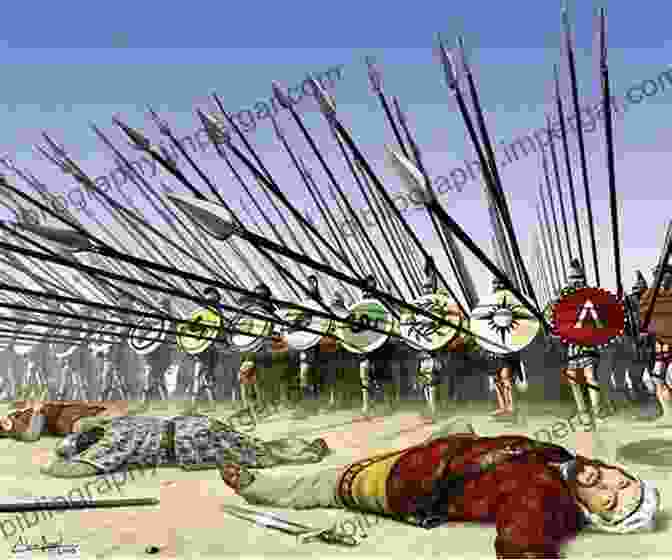Unveiling the Clash of Titans: Land Battles in 5th Century BC Greece


The 5th century BC was a pivotal era in the history of Greece, marked by transformative conflicts that shaped the political, military, and cultural landscape of the region. Among these pivotal clashes, land battles played a crucial role in determining the fate of Greek city-states and the rise of powerful alliances. This article delves into the intricacies and significance of land battles in 5th century BC Greece, exploring the strategies, tactics, and weapons that defined these epic confrontations.
4.8 out of 5
| Language | : | English |
| File size | : | 4372 KB |
| Text-to-Speech | : | Enabled |
| Screen Reader | : | Supported |
| Word Wise | : | Enabled |
| Print length | : | 323 pages |
Hoplite Infantry: The Core of Greek Armies
Hoplites, heavily armed infantrymen, formed the backbone of Greek armies in the 5th century BC. These warriors donned bronze helmets, breastplates, greaves, and carried large, round shields. Their primary weapon was the spear, typically measuring between 2 and 3 meters in length. Hoplites fought in tightly packed formations called phalanxes, presenting a formidable wall of shields and spears to the enemy.
The phalanx was a highly effective formation, particularly in close-quarters combat. It could withstand cavalry charges and break enemy lines with its sheer weight and momentum. However, the phalanx also had limitations. It was slow and cumbersome to maneuver, vulnerable to attacks from the flanks or rear, and ineffective in mountainous or uneven terrain.
Cavalry and Light Infantry
While hoplite infantry constituted the primary fighting force, cavalry and light infantry played important roles in Greek armies. Cavalry, composed of wealthy citizens who could afford horses, provided mobility and swift attacks. They were used for scouting, raiding, and pursuing fleeing enemies. Light infantry, often armed with javelins, bows, or slings, provided ranged support and harassed the enemy from afar. They operated in loose formations, exploiting terrain and harassing enemy flanks.
Prominent Land Battles of the 5th Century BC
Numerous land battles in the 5th century BC had profound historical consequences. Some of the most notable include:
- Battle of Marathon (490 BC): A decisive victory for the Athenians and their allies over the invading Persian army. The battle marked the beginning of the Greco-Persian Wars and demonstrated the effectiveness of the hoplite phalanx against a numerically superior enemy.
- Battle of Plataea (479 BC): The final battle of the Greco-Persian Wars, where the allied Greek forces decisively defeated the Persian army. The battle confirmed the supremacy of the hoplite phalanx and marked the end of the Persian threat to Greece.
- Battle of Thermopylae (480 BC): A heroic but ultimately tragic stand by the Spartans and their allies against the overwhelming Persian army. Despite their defeat, the battle became a legend of Greek bravery and sacrifice.
- Battle of Leuctra (371 BC): A revolutionary battle where the Thebans, led by Epaminondas, employed innovative tactics to defeat the vaunted Spartan phalanx. The battle demonstrated the vulnerability of the phalanx to oblique attacks and marked the decline of Spartan military dominance.
Tactics and Strategies
Greek generals and strategists developed a range of tactics and strategies to maximize the effectiveness of their armies. Common tactics included:
- Phalanx advance: Hoplites would advance in a tightly packed formation, pushing their shields together to create a solid barrier. They used their spears to stab at the enemy, aiming for the gaps between their shields or under their helmets.
- Oblique attack: A tactic developed by Epaminondas at Leuctra, where a portion of the phalanx pushed forward at an angle, creating a wedge that could break through an enemy line.
- Cavalry charges: Cavalry was used for swift attacks against enemy flanks or to pursue fleeing adversaries. They carried lances or javelins and wore lighter armor than hoplites.
- Light infantry harassment: Light infantry would attack from a distance, using javelins, arrows, or slings to harass and weaken the enemy.
Weapons and Armor
The weapons and armor used by Greek hoplites were vital to their success on the battlefield. The primary weapon was the spear, a long shaft with a pointed metal tip. Hoplites also carried a short sword for close-quarters combat. Their shields, known as hoplons, were made of wood and covered with bronze to provide protection from enemy attacks.
In addition to the phalanx, hoplites wore a range of protective armor. Bronze helmets protected their heads, while breastplates, greaves, and shields defended their bodies from weapons. Despite the effectiveness of their armor, hoplites were vulnerable to wounds inflicted through gaps in their protection or from heavy blows that could penetrate their armor.
Land battles in 5th century BC Greece were fierce and decisive clashes that played a pivotal role in shaping the political, military, and cultural landscape of the region. The hoplite phalanx formed the core of Greek armies, providing a formidable wall of shields and spears. Cavalry, light infantry, and innovative tactics complemented the phalanx, creating a versatile and effective fighting force. The battles of Marathon, Plataea, Thermopylae, and Leuctra showcased the skill, bravery, and determination of Greek warriors and cemented their place in military history. Through these battles, the Greeks forged a legacy of military prowess that would continue to inspire and influence military thought for centuries to come.
References
- Cartledge, P. (2012). The Cambridge history of the Peloponnesian War. Cambridge University Press.
- Freeman, P. Alexander (2011). Alexander the Great. Simon & Schuster.
- Lazenby, J. F. (2009). The defense of Greece 490–479 BC. Aris & Phillips Ltd.
- Raaflaub, K. A. (2004). The wars of the Greeks: 495–386 BC. Routledge.
- Roisman, J., & Yardley, J. C. (Eds.). (2011). Ancient Greece: A history in eleven chapters. Blackwell Publishing.
4.8 out of 5
| Language | : | English |
| File size | : | 4372 KB |
| Text-to-Speech | : | Enabled |
| Screen Reader | : | Supported |
| Word Wise | : | Enabled |
| Print length | : | 323 pages |
Do you want to contribute by writing guest posts on this blog?
Please contact us and send us a resume of previous articles that you have written.
 Book
Book Novel
Novel Page
Page Chapter
Chapter Text
Text Story
Story Genre
Genre Reader
Reader Library
Library Paperback
Paperback E-book
E-book Magazine
Magazine Newspaper
Newspaper Paragraph
Paragraph Sentence
Sentence Bookmark
Bookmark Shelf
Shelf Glossary
Glossary Bibliography
Bibliography Foreword
Foreword Preface
Preface Synopsis
Synopsis Annotation
Annotation Footnote
Footnote Manuscript
Manuscript Scroll
Scroll Codex
Codex Tome
Tome Bestseller
Bestseller Classics
Classics Library card
Library card Narrative
Narrative Biography
Biography Autobiography
Autobiography Memoir
Memoir Reference
Reference Encyclopedia
Encyclopedia James Givens
James Givens Gambero Rosso
Gambero Rosso Gary Gates
Gary Gates Gary A Depaul
Gary A Depaul Frederica Mathewes Green
Frederica Mathewes Green Gary L Friedman
Gary L Friedman Jerry D Moore
Jerry D Moore Fred D Cavinder
Fred D Cavinder Fiona Broadley
Fiona Broadley Fletcher Mckenzie
Fletcher Mckenzie Gabriel Rockhill
Gabriel Rockhill Tony Ray
Tony Ray Jesse Odom
Jesse Odom Frank Boccia
Frank Boccia Keith S Dobson
Keith S Dobson Eunice Lewis Ph D
Eunice Lewis Ph D Fred Minnick
Fred Minnick Frederick Parker
Frederick Parker Gary Rivlin
Gary Rivlin Marjorie Perloff
Marjorie Perloff
Light bulbAdvertise smarter! Our strategic ad space ensures maximum exposure. Reserve your spot today!

 Nathaniel HawthorneInnovative Ideas for Sustainable Built Environment: Redefining the Future of...
Nathaniel HawthorneInnovative Ideas for Sustainable Built Environment: Redefining the Future of... Terry BellFollow ·3.4k
Terry BellFollow ·3.4k Gordon CoxFollow ·13.8k
Gordon CoxFollow ·13.8k Eric HayesFollow ·8k
Eric HayesFollow ·8k Caleb LongFollow ·9.2k
Caleb LongFollow ·9.2k Harrison BlairFollow ·7.9k
Harrison BlairFollow ·7.9k Giovanni MitchellFollow ·10.3k
Giovanni MitchellFollow ·10.3k Colby CoxFollow ·11.9k
Colby CoxFollow ·11.9k Rodney ParkerFollow ·11.2k
Rodney ParkerFollow ·11.2k

 Alexander Blair
Alexander BlairBecoming Sports Agent Masters At Work: The Ultimate Guide
What is a Sports...

 Xavier Bell
Xavier BellUnveiling the Enchanting World of Upper Bohemia: A Review...
A Captivating...

 Chris Coleman
Chris ColemanUnveiling the Secrets: Extreme Rapid Weight Loss Hypnosis...
In the relentless pursuit of a slimmer,...
4.8 out of 5
| Language | : | English |
| File size | : | 4372 KB |
| Text-to-Speech | : | Enabled |
| Screen Reader | : | Supported |
| Word Wise | : | Enabled |
| Print length | : | 323 pages |
















